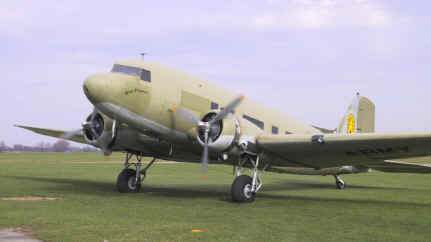|
Douglas C-47 Skytrain / Dakota
(Variants/Other Names: AC-47; C-53; C-117; DC-3; EC-47; Lisunov Li-2/PS-84; Nakajima/Showa L2D; R4D, VC-47)

Douglas DC-3/C-47 Serial #1918, N17332, at Poplar Grove Airport, Illinois, USA. Photo by Buck Wyndham.
"Probably the most memorable thing about the Dakota was the smell. The odour of the leather mixed with hydraulic fluid made a perfume second to none. The Dakota always treated me well, unlike some of the other birds I've flown, and my memories of it are all good."
-- Tex Gehman, Winnipeg, Canada |
History:The Douglas DC-3 was born of the intense competition for modern commercial aircraft that characterised the post-World War I era. It was the direct descendant of the DC-1, which first flew in 1933 as Douglas' initial response to a short supply of competitor, Boeing Aircraft's, landmark 10-passenger 247, the first, low-wing, all-metal airliner. With only one 12-passenger sample flying, and already a record-breaking success, the DC-1 was quickly made obsolete, replaced by an a more powerful version with greater seating capacity, the 14-passenger DC-2, of which 193 were built.
When, in 1934, American Airlines asked Douglas for a larger version of the DC-2 that would permit sleeping accommodations for transcontinental flights, Douglas responded with the 24 passenger (16 as a "sleeper" craft) DST (Douglas Sleeper Transport), the 24-passenger version of which was designated DC-3.
The DC-3 is given most of the credit for an almost 600% increase in airline passenger traffic between 1936 and 1941. Recognising its great potential as a military transport, the United States Army specified a number of changes needed to make the aircraft acceptable for military use, including more powerful engines, the removal of airline seating in favour of utility seats along the walls, a stronger rear fuselage and floor, and the addition of large loading doors. A large order was placed in 1940 for the military DC-3, which was designated C-47 and became known as "Skytrain," a name it would soon be asked to live up to.
Used as a cargo transport to fly the notorious "Hump" over the Himalayas after the Japanese closed the Burma Road, and as a paratroop carrier in various campaigns from Normandy to New Guinea, the Douglas C-47 was one of the prime people movers of WWII where, in one form or another, it was manufactured by belligerents on both sides, after first having been licensed to Mitsui before the Japanese attack on Pearl Harbor, and to the Russians, who manufactured it under license as the Lisunov Li-2. During the war, Mitsui built their own version, via contract with the Showa and Nakajima companies, which built about 485 "Tabbys" (the code name given to the aircraft by the Allies) as the Showa L2D.
Known also as "Dakota" (British designation), R4D (U.S. Navy), "Skytrooper" and "Gooney Bird," the Douglas C-47 (USAAF) went through many modifications during its long service life, largely with respect to engine power ratings, but also with structural modifications for specific tasks like reconnaissance and navigation training. It was even tested as a floatplane, and as an engineless glider, a task it performed well, but too late in the war to matter. It was also used as a fighting machine as the AC-47D gunship ( "Puff, the Magic Dragon") of the Vietnam war, where the plane was equipped with three modernised Gattling guns (General Electric 7.62mm "Miniguns," each mounted and firing from the port side) for use as a "target suppressor," circling a target and laying down massive fire to eliminate or at least subdue the enemy position.
By the end of the war, 10,692 of the DC-3/C-47 aircraft had been built, with 2,000 Li-2s by the Soviets, and 485 Showa L2Ds by the Japanese, for a total of about 13,177. Between its first flight on December 17, 1935, and this writing, the DC-3 will have had 69 years of continuous service. From its pioneering of military airlifts over the hump, to its perfecting of the technique during the Berlin Airlift, the C-47 has been prized for its versatility and dependability, factors that explain its remarkable longevity as an active carrier worldwide.
Nicknames: Gooney Bird; Super DC-3 (R4D-8); Skytrooper; Biscuit Bomber; Tabby (NATO code name for the Showa L2D); Cab (NATO code name for Lisunov Li-2); EM>Dumbo (SC-47 Search-and Rescue variant); Sister Gabby/Bullshit Bomber (EC-47 dispensing propaganda-leaflets in Vietnam); Spooky/Puff the Magic Dragon (AC-47 Gunship); Dowager Duchess; Old Methuselah; The Placid Plodder; Dizzy Three; Old Bucket Seats; Duck; Dak; Dakleton (South African C-47s which replaced their Avro Shackletons), Vomit Comet (Nickname used by US Army paratroops during the Normandy invasion.)
| Specifications | C47/DC3 |
| Wingspan | 95ft. 0in. |
| Height | 16ft. 11.5in.. |
| Length | 64ft. 5.5in. |
| Weight (empty) | 16,865 lbs. |
| Weight (combat) | 25,200 lbs. |
| Powerplants | Two Whitney R-1830-S1C3G Twin Wasp radial piston engines. |
| Maximum Speed | 230 mph |
| Cruising Speed | 207 mph |
| Ceiling | 23,200 ft. |
| Range | 2,125 miles(3,703 km) |
| Crew | Usually 5 |
| Number built - all variants | 13,177 |
| Number still airworthy | 300 + |
Return to listing of incidents 'click' on this button.
 |
|